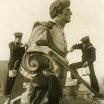-
Posts
1,222 -
Joined
-
Last visited
Reputation Activity
-
 jbshan got a reaction from BETAQDAVE in The Kit-Basher's Guide To The Galaxy
jbshan got a reaction from BETAQDAVE in The Kit-Basher's Guide To The Galaxy
If rubber bands glued to your tweezers doesn't do anything for the inner man/woman, try some small heat-shrink insulation tubing from Radio Shack or an Auto Parts store. Slide the tubing over the pointy parts of the tweezers and apply heat. A match might even be hot enough, or a hair dryer.
There are many sizes and colors.
-
 jbshan got a reaction from shipman in The Kit-Basher's Guide To The Galaxy
jbshan got a reaction from shipman in The Kit-Basher's Guide To The Galaxy
If rubber bands glued to your tweezers doesn't do anything for the inner man/woman, try some small heat-shrink insulation tubing from Radio Shack or an Auto Parts store. Slide the tubing over the pointy parts of the tweezers and apply heat. A match might even be hot enough, or a hair dryer.
There are many sizes and colors.
-
 jbshan got a reaction from thibaultron in Unloading cargo from tall ships
jbshan got a reaction from thibaultron in Unloading cargo from tall ships
Normal work on a square-rigger took some 4-5,000 calories a day. That's better than many ashore could get. (c. 1800 or so)
Stuff needing to be moved on board would be brought to the hatch below the hoisting gear and lifted from there. Even mounting a gun barrel onto its carriage might be done with the gear midships.
As shown in the sheet (on the link I posted) loads needing to go outboard, the hoisting gear would get it up in the air, then tackles from the main and fore yards would be used to swing it outboard and lower into boats. Reverse to load something inboard.
On a model, you could certainly show a ship's boat being hoisted in- or outboard using the yards. If you definitively knew there was a crane aboard you could show that. The 'crane' has a diagonal spar with tackle on the end, this is the 'jib' and jib cranes are still in use everywhere.
-
 jbshan got a reaction from thibaultron in Unloading cargo from tall ships
jbshan got a reaction from thibaultron in Unloading cargo from tall ships
Here is a partial description of some hoisting gear:
http://uvsmgshipmodelguild.wikispaces.com/Hoisting+Tackle
This is all self-contained, and could be used for hoisting boats, cargo, guns, whatever. There has always been a need to load and unload heavy items.
-
 jbshan got a reaction from Jorge Diaz O in What is the name for the netting under the bowsprit
jbshan got a reaction from Jorge Diaz O in What is the name for the netting under the bowsprit
Shipaholic's netting would be to hold the staysail when it is not set. Reference David Antscherl's 'Fully Framed Model'.
-
 jbshan got a reaction from Skol in Sanding sticks
jbshan got a reaction from Skol in Sanding sticks
I make my own with stripwood and double stick tape. You can have whatever grit you want, whatever shape or size of stick. As the grit wears down, I use it as finer grit. I keep several going at one time.
-
 jbshan got a reaction from EricWilliamMarshall in Restoration of Bassett Lowke "Albertic" by michael mott - FINISHED - Scale 1:100
jbshan got a reaction from EricWilliamMarshall in Restoration of Bassett Lowke "Albertic" by michael mott - FINISHED - Scale 1:100
The different hobby houses have wire. Bass pro shops would have fishing tackle wire. All you need is a drill to make wire into rope, it doesn't need the same torsion control as fiber rope. Do please try to do a neater job on the whipping of the ends than the original builder. Any picture wire I've worked with turns gray and nasty looking, plus I think it is a weave instead of a twist.
Your repaint scheme sounds as if it should work.
You also have, mostly, a damaged side and an undamaged side for comparison. I've seen some where both sides are 'gone' which must make it tougher to restore.
-
 jbshan got a reaction from Larry Cowden in Lexington by jbshan - The Lumberyard - 1/64 - from the Seaways Practicum by Clay Feldman
jbshan got a reaction from Larry Cowden in Lexington by jbshan - The Lumberyard - 1/64 - from the Seaways Practicum by Clay Feldman
To blow these up, open in a new tab or window. I then see a magnifying glass with a '+' inside, or use the prompt under 'view' for zoom + or -.
Here's about the next one in sequence. I took it to show the transom and stern lights but it will serve to show the planking process.
First, having faired the blocking on the exterior, I put one strake of swiss pear along the bottom of the port openings. Using a batten to line this up makes this strake go in nicely. Next were the two strakes between the ports, again of swiss pear, then one more full strake. I held the strakes between the ports just to the edge of the openings in the blocking.
The black strakes of plank are ebony. It is evil stuff. Next time I would use walnut or some other dark wood if I wanted the contrast in color.
Here is a closer view of the square tuck stern. The planking is fairly straightforward here, though the photo is kind of blurry. The tafferail area is backed with some scrap 1/32" plywood and planked horizontally with swiss pear. The stern lights I will deal with in their own section. Below that is the counter, curved inward and set by a block that I think shows in one of the earlier pics. Below that is the tuck area that I planked diagonally, lower outboard rising to the center line. [edit: The stern post is applied on top of the plank.]
I think you can see that I have left the top molding for the stern lights and the ends of the tuck long, later to be brought down flush, either to the side plank or to allow the bottom plank to run by and be in turn sanded back flush. There will be short horizontal pieces of plank outboard of the stern lights added before that area is brought back flush with the side.
-
 jbshan got a reaction from Larry Cowden in Lexington by jbshan - The Lumberyard - 1/64 - from the Seaways Practicum by Clay Feldman
jbshan got a reaction from Larry Cowden in Lexington by jbshan - The Lumberyard - 1/64 - from the Seaways Practicum by Clay Feldman
I haven't mentioned anywhere, I intend leaving the wood with a clear finish, it's so pretty. When I was planking up large areas, I would keep several lengths of stock to hand, grabbing from different ones for each plank in a strake, so the color variation would show up the individual planks.
-
 jbshan got a reaction from Larry Cowden in Lexington by jbshan - The Lumberyard - 1/64 - from the Seaways Practicum by Clay Feldman
jbshan got a reaction from Larry Cowden in Lexington by jbshan - The Lumberyard - 1/64 - from the Seaways Practicum by Clay Feldman
Here's what I have for the stern lights.
The top assembly is the outer frame, what you see on the model.
The lower assembly is the inner frame. This fits in from the back, so you only see the edges of it.
The slots are to take the mullions and muntins for the individual panes of glass. I made these of heavy thread as I doubted my ability to work so small in wood, though the quarter lights have changed my mind on that.
Once the cross pieces were in place, on top of those (behind both the frames and mullions) I glued small pieces of mica or isinglass, once used in wood stoves for little windows, and earlier used for lights on ships, fancy that. I used fly fishing head cement which is clear, almost liquid, does not have the white powder you get with CA, and merely adds to the character of the mica sheet. I also used it to glue in the thread, and to glue the joints in the thread.
Since the backing for this whole area is almost touching, I painted the backing black, which allows the mica just enough reflection so it shows nicely, I think.
-
 jbshan got a reaction from Larry Cowden in Lexington by jbshan - The Lumberyard - 1/64 - from the Seaways Practicum by Clay Feldman
jbshan got a reaction from Larry Cowden in Lexington by jbshan - The Lumberyard - 1/64 - from the Seaways Practicum by Clay Feldman
Here's about the earliest one, clamping a batten for the sheer. The top and bottom blocking for the ports is in. The kit is the standard 'egg crate' construction. It is a square tuck stern so pretty simple back there.
I learned building Niagara by Model Shipways to block in the ports between the frames. It locates them securely and really stiffens things up. I ran battens for the top and bottom lines of the ports then measured for locations fore n' aft. One each side needed the frame to be cut right out, about midships. The third back needed the frame cut, but had blocking adjacent on the fore side to support the edge. The forward ports had to be at an angle because of the curve in toward the bows and that angle had to be allowed for.
I make the blocking proud of the frames, then sand back to a smooth surface. The blocking makes putting in the port lining much easier later on. This vessel has the plank basically following the ports, but I would think this method would help with those where the plank does not line up, and easier than trying to measure each port out and cut already installed planking.
I may remember more as we go but this is it for now on these pics.
-
 jbshan got a reaction from EricWilliamMarshall in HMS Warspite by Old Collingwood - FINISHED - Academy - 1/350 scale - PLASTIC
jbshan got a reaction from EricWilliamMarshall in HMS Warspite by Old Collingwood - FINISHED - Academy - 1/350 scale - PLASTIC
I've found several images showing a couple of chains (?) between the forward fairlead and jack staff leading down and a bit aft, both anchored and underway. They may have intended to hook up the paravane, use it, then, upon recovery, restow the chain.
I still don't think they would have let her anywhere near enemy-mined waters, at least without an escort more suitable for that work.
-
 jbshan got a reaction from EricWilliamMarshall in The Kit-Basher's Guide To The Galaxy
jbshan got a reaction from EricWilliamMarshall in The Kit-Basher's Guide To The Galaxy
One of our members needed whip antennas for a destroyer model. His son had left his drum set behind when he moved out. The wire brushes from the drums provided long straight wire that wouldn't bend easily.
-
 jbshan got a reaction from thibaultron in Novel Way of Making a Stay Mouse
jbshan got a reaction from thibaultron in Novel Way of Making a Stay Mouse
Looks pretty good. Thanks for sending that tip along.
-
 jbshan got a reaction from JerseyCity Frankie in 18th and early 19th Century cutter models
jbshan got a reaction from JerseyCity Frankie in 18th and early 19th Century cutter models
Beautiful. Thank you for sharing. I had a less intense but equally positive experience with the NMM folks a few years ago, refuting the horror stories I had heard.
I seem to see a few yards set on horses, but some not. Are any of these vessels set up with sliding bowsprits?
I take particular note of the stay coming down to a deadeye in a loop, with the lower 'dead' sheaves drilled through the stem head. I've never seen that, but it might come in handy.
-
 jbshan got a reaction from EricWilliamMarshall in Muscongus Bay lobster smack by macsparty - Midwest Products - first build
jbshan got a reaction from EricWilliamMarshall in Muscongus Bay lobster smack by macsparty - Midwest Products - first build
I did one of these ages ago. It's a pretty little boat.
Mine had blocking forward of the forward bulkhead. The 'plank' ended at that bulkhead. The blocking must stand proud of the bulkhead sufficient to continue the line of the planking, without being itself sheathed. Check before you trim that blocking too far down so you won't have to build it back up to match the plank.
-
 jbshan got a reaction from jchbeiner in English Flags on a Launching
jbshan got a reaction from jchbeiner in English Flags on a Launching
I just learned that at the same time as the Cross of St. Patrick appeared on the Union Flag, 1/01/01, the fleur de lis vanished from the Royal Standard, so another way to date a painting or other source.
Joel Sanborn
-
 jbshan got a reaction from jchbeiner in English Flags on a Launching
jbshan got a reaction from jchbeiner in English Flags on a Launching
The best documented source I have is an illustration in 'Naval Warfare in the Age of Sail', Brian Tunstall, p. 44. It is four pages from 'Instructions for the better Ordering his Majesties Fleet, no date (c1688) MOD'
One of the pages shows 'Signalls by which the Generall calls the Capitall Officers &c. on board his Ship.' The third signal is 'If ye Standard be put in ye same place [that is in the mizzen shrouds] then ye Flags Officers only are to repair on Board.' It's pretty small and cursive and the spelling is strange to my eye, but that's the gist of it. The title page is stamped 'Admiralty Office Library'.
Another (p 41) is a page from 'AN INDEX OF THE SIGNALS CONTAINED IN THE INSTRUCTIONS for SAYLING.' This is variously dated, part printed under James II, part under William and Mary, so 1688-1689.
Just as an example, 'SIGNALS with One Gun. From the Admiral. #3 One Gun, and a Union Flag, or Ensign, or Standard, or a Red Flag, or a White Flag, or a Blew Flag, put in the Miffen-Shrouds........ Page 5 Letter 8' NMM, SIG/A/5 and 6
Apparently you would read the signal, go to the correct page, and would learn what one gun and a standard in the Mizzen shrouds meant you to do.
Remember, times change.
Joel Sanborn
-
 jbshan got a reaction from jchbeiner in English Flags on a Launching
jbshan got a reaction from jchbeiner in English Flags on a Launching
In 'Restoration Warship' Richard Ensor, author and illustrator, shows Lenox at launch with, in order, Jack, Lord High Admiral, Royal Standard, Union Flag and Red Ensign at ensign staff. He says it is based on a period source. Additionally, there is a detail shown from 'A Geometric Plan of Deptford Dockyard', Thomas Milton, 1753 with the flags in the same order. This may be a standard arrangement. A vessel with fewer masts might leave off the Union Flag, then perhaps the Lord High Admiral's flag for a single masted vessel.
In the case of Lenox, Charles II was present, but I have read that it was presumed in all cases that the Sovereign was present at the launch of one of his ships so his Standard was flown. The precedence of the flags would not be altered, in my opinion.
In preperation for the launch of Lenox, arrangement was made for poles to be stepped in the mast locations, presumably from yard stocks, to which they could be returned when the ceremonies were concluded.
As to size, the largest ensign a ship carried would be equal to the ship's beam in the fly, so Lenox's would be in the neighborhood of 40 feet in the fly. The Jack was equal to the union of the Ensign, so perhaps 20 feet in the fly. Royal Standards, Lord High Admiral, etc. would be the same as Ensigns. Flags were sized by 'breadths', the width of the fabric as it came from the loom, which I must do further research on. There were only standard sizes stocked, so the correspondence between ship's beam and flag size would be approximate.
Ships were issued flags and signals from the dockyard, so, again, as with the poles, they would have come from stock to which they could be returned, and the largest sizes could be used whatever the ship will eventually be issued.
Lenox at launch, Ensor's painting:
Joel Sanborn
-
 jbshan got a reaction from jchbeiner in Colors on ships
jbshan got a reaction from jchbeiner in Colors on ships
Most interesting, Wayne, as you note, that there is no red pigment listed.
'Verdigris' is a pigment name, though as an artists' color it is not very saturated and is fugitive with exposure to light. It is green. The Prussian Blue listed just after is a strong, permanent blue-green pigment that will stand much mixing with other colors and white. It becomes, with white, a sky blue or robin's egg blue, just as a guide. With white and yellow ochre it would become green, but not very bright, because the yellow is dull.
-
 jbshan got a reaction from CaptainSteve in New and need help to identify a mystery model? Read here first!
jbshan got a reaction from CaptainSteve in New and need help to identify a mystery model? Read here first!
If you're collecting comments, there are indeed valuable models resembling the usual yard sale/family heirloom. These are usually hundreds of years old and are already in museums, so yours is probably not one of them.
-
 jbshan got a reaction from druxey in Caroline's bottom
jbshan got a reaction from druxey in Caroline's bottom
Given the recipes I found were with yellow peas, I wonder if 'pease porridge' might include sulphur. I'm thinking maybe the old 'tallow bottom' made with tallow and soap, that lasted only a few months. If that were mixed with sulphur, maybe it would not mix well and be a bit lumpy, hence 'pease porridge' looking.
-
 jbshan got a reaction from BETAQDAVE in Nuestra Señora del Pilar by Anja & Sjors - FINISHED - OcCre - Scale 1:46
jbshan got a reaction from BETAQDAVE in Nuestra Señora del Pilar by Anja & Sjors - FINISHED - OcCre - Scale 1:46
Marcus, just to expand on your choices, and not to imply anything of the sort could have happened to Anja, a friend of mine was transporting a fairly large model of a small rowing boat and set the model down while he opened the back of the car to load it. He got distracted and failed to load the model before he backed out of the driveway. It took him a few years to get over the trauma.
-
 jbshan got a reaction from John Allen in Philadelphia by Elijah - Model Shipways - 1:24 Scale - Continental Gunboat
jbshan got a reaction from John Allen in Philadelphia by Elijah - Model Shipways - 1:24 Scale - Continental Gunboat
Welcome to the world of Philadelphia. There are several folks with logs here. If you saved or can get the issues of Ships in Scale that contain the build by Kurt van Dam that is another resource.
-
 jbshan got a reaction from Julie Mo in How Realistic Can One Make Sails?
jbshan got a reaction from Julie Mo in How Realistic Can One Make Sails?
Eric, I like that look also.
The scale of the model will partially determine what is best. Smaller scales will only need the pencil lines, medium scales could use the glued panels (had you thought of drawing in some of the detail with pencil here also?) while large scales could have more or less sewn construction.







.thumb.jpeg.fc5d633a7b34428fcf19419a73d56d55.jpeg)




